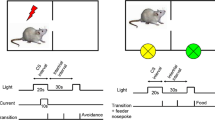Abstract
The ability of ethanol to motivate avoidance responding was used as a measure of the drug's aversive stimulus properties. In Experiment I, four groups of rats were infused with either ethanol (200, 400, 800 mg/kg IV) or saline if they failed to jump a high hurdle. The ethanol groups acquired the jumping response (active avoidance), while the saline group only showed a tendency not to jump. In Experiment II, the hypothesis was tested that the same infusions might be self-administered if the contingency were reversed so that responses produced rather than avoided the drug. Four groups of rats were given the same doses of ethanol or saline if they traversed a runway and entered a goal box. Initially, all animals made the response, however the drugtreated groups eventually showed a dose-dependent tendency to refrain from entering the goal box (passive avoidance). Thus ethanol can maintain behavioral control similar to that produced by commonly used aversive stimuli (e.g. foot shock) and can do so at lower doses than those found to be effective in previous reports of ethanol-mediated aversions. It is suggested that the mechanism by which ethanol comes to be a reinforcing agent must take into account the pervasive negative properties of the drug.
Similar content being viewed by others
References
Bolles RC (1970) Species-specific denfense reactions and avoidance learning. Psychol Rev 77:32–48
Cappell HD, LeBlanc AE (1983) The relationship of tolerance and physical dependence to alcohol abuse and alcohol problems. In: Kissin B, Begleiter H (eds) The biology of alcoholism. Plenum Press, New York (in press)
Cappell HD, LeBlanc AE, Endrenyi L (1973) Aversive conditioning by psychoactive drugs: Effects of morphine, alcohol and chlordiazepoxide. Psychopharmacology 29:239–246
Cicero TJ (1979) A critique of animal analogues of alcoholism. In: Majchrowicz T, Noble EP (eds) Biochimstry and pharmacology of ethanol, vol 2. Plenum, New York, pp 533–568
Cunningham C (1981) Spatial aversion conditioning with ethanol. Pharmacol Biochem Behav 14:263–264
Grupp LA (1981a) An investigation of intravenous ethanol selfadministration in rats using a fixed ratio schedule of reinforcement. Physiol Psychol 9:359–363
Grupp LA (1981b) Ethanol as the negative reinforcer in an active avoidance paradigm. Prog Neuropsychopharmacol 5:241–244
Lester D, Nachman M, LeMagnen J (1970) Aversive conditioning by ethanol in the rat. Q J Stud Alcohol 31:578–586
Meisch RA (1976) Function of schedule-induced polydipsia in establishing ethanol as a positive reinforcer. Pharmacol Rev 27:465–473
Mello NK (1977) Stimulus self-administration: Some implications for the prediction of drug abuse liability. In: Thompson T, Unna KR (eds) Predicting dependence liability of stimulant and depressant drugs. University Park Press, Baltimore, pp 243–260
Morse WH, Kelleher RT (1977) Determinants of reiuforcement and punishment. In: Honig WK, Staddon JER (eds) Operant behavior. Prentice Hall, Englewood Cliffs, pp 174–200
Rozin P, Kalat JW (1971) Specific hungers and poison avoidance as adaptive specializations of learning. Psychol Rev 78:459–486
Smith SG, Davis WM (1974) Intravenous alcohol self-administration in the rat. Pharmacol Res Commun 6:397–401
Steiner S, Beer B, Schaffer M (1969) Escape from self-produced rates of brain stimulation. Science 163:90–91
Stewart RB, Grupp LA (1981) An investigation of the interaction between the reinforcing properties of food and ethanol using the place-preference paradigm. Prog Neuropsychopharmacol 5:609–613
Author information
Authors and Affiliations
Rights and permissions
About this article
Cite this article
Grupp, L.A., Stewart, R.B. Active and passive avoidance behaviour in rats produced by IV infusions of ethanol. Psychopharmacology 79, 318–321 (1983). https://doi.org/10.1007/BF00433409
Received:
Accepted:
Issue Date:
DOI: https://doi.org/10.1007/BF00433409




